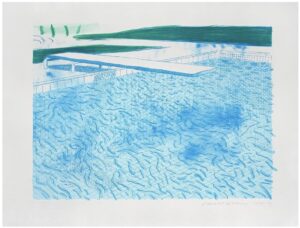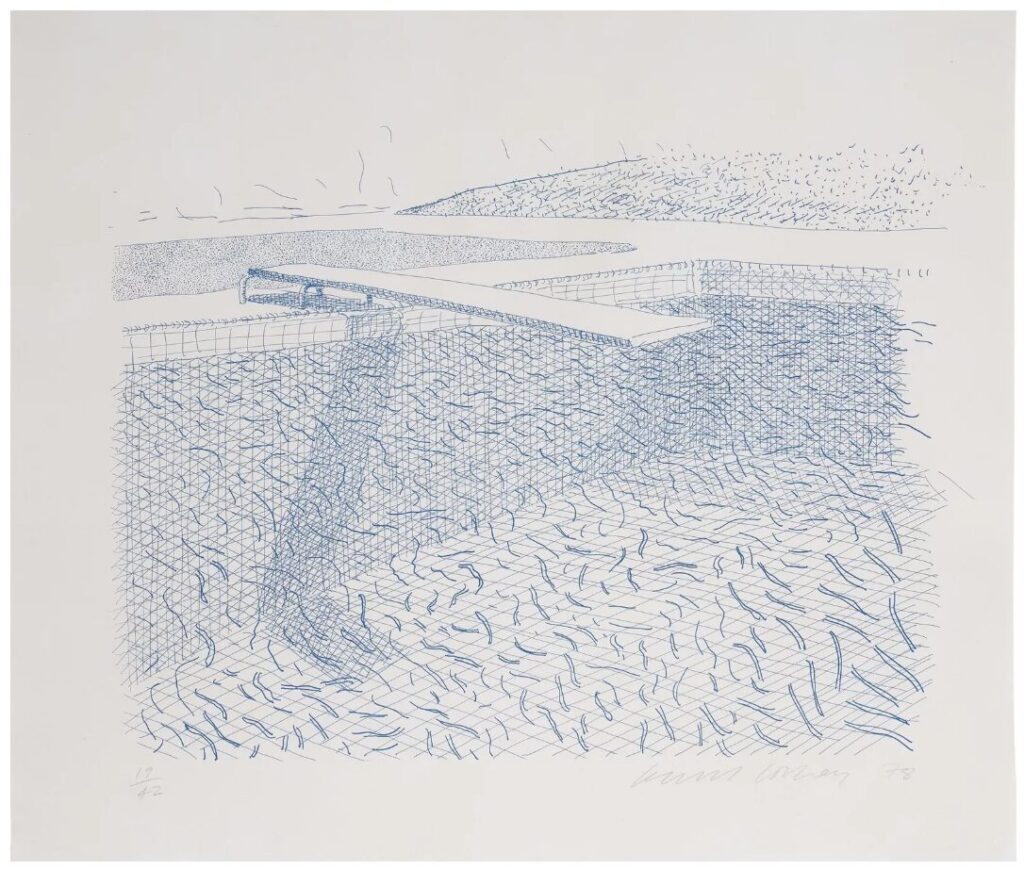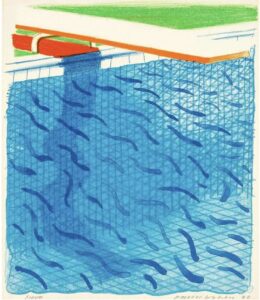David Hockney Pool Prints: Complete Guide to His Most Famous Swimming Pool Art
· blog
David Hockney pool prints represent some of the most iconic and sought-after artworks in contemporary British art. These mesmerizing pool series artwork pieces have captivated collectors and art enthusiasts worldwide, combining Hockney’s masterful technique with his fascination for California’s sun-soaked lifestyle. From the legendary “A Bigger Splash” print to lesser-known gems in his water-themed collection, Hockney pool prints continue to define modern pool art and remain highly coveted in today’s art market.
The Genesis of Hockney’s Pool Obsession
David Hockney’s love affair with swimming pools began in the early 1960s when he first visited Los Angeles. The British artist was immediately struck by the prevalence of backyard pools in California suburbia – a stark contrast to the industrial landscapes of his Yorkshire homeland. This cultural shock would inspire what became his most famous body of work: the California pool art series that would establish him as a leading figure in the Pop Art movement.
The artist’s first encounter with swimming pool prints came through his own paintings, which he later adapted into various print media. Hockney was fascinated by the technical challenge of representing water – its transparency, movement, and the way light danced across its surface. This obsession with capturing the essence of water would drive him to create some of the most recognisable swimming pool prints in art history.
“A Bigger Splash” Print: The Crown Jewel
When discussing David Hockney pool prints, no work is more significant than “A Bigger Splash” print. Originally painted in 1967, this masterpiece was later reproduced as limited edition prints that have become incredibly valuable. The “A Bigger Splash” print captures a moment of perfect stillness interrupted by dynamic movement – the splash frozen in time against the backdrop of a pristine modernist house and palm trees.
The composition of “A Bigger Splash” print demonstrates Hockney’s mastery of color and form. The brilliant blue of the pool contrasts sharply with the pink and white architecture, while the splash itself becomes a burst of white energy against the calm water. This print exemplifies everything that makes Hockney water prints so captivating: the interplay between stillness and movement, the California lifestyle aesthetic, and the artist’s unique ability to capture light and atmosphere.
The “A Bigger Splash” print has been reproduced in various formats, including lithographs, screen prints, and digital reproductions. Original signed editions command premium prices at auction, often selling for hundreds of thousands of dollars, making them among the most valuable swimming pool prints ever created.
The Evolution of Pool Series Artwork
Hockney’s pool series artwork spans several decades and encompasses dozens of individual works. The series began with his early pool paintings in the 1960s and continued to evolve as the artist experimented with different techniques and perspectives. Each phase of his pool series artwork reflects not only his growing technical mastery but also his deepening understanding of California’s unique light and lifestyle.
The early pool series artwork from the 1960s focuses on the geometric perfection of suburban pools, often viewed from above or at oblique angles. These works emphasize the artificial nature of these aquatic oases in the desert landscape of Southern California. As Hockney’s pool series artwork progressed into the 1970s and beyond, the artist began incorporating more human elements – figures swimming, diving, or lounging poolside.
One particularly notable evolution in the pool series artwork is Hockney’s treatment of water itself. Early works depicted water as flat, almost abstract surfaces, while later pieces in the series showcase increasingly sophisticated representations of water’s transparency, refraction, and movement. This technical progression makes tracking the chronology of his pool series artwork a fascinating journey through the artist’s development.

Technical Mastery in Hockney Water Prints
The creation of David Hockney pool prints involved various printmaking techniques, each chosen to best capture the specific qualities of water and light that fascinated the artist. Hockney water prints demonstrate his mastery of lithography, a medium that allowed him to achieve the subtle color gradations and smooth surfaces essential to his pool imagery.
In his lithographic Hockney water prints, the artist employed innovative techniques to represent water’s unique properties. He developed methods for creating the illusion of transparency, using overlapping colors and careful registration to suggest depth beneath the water’s surface. The ripples and distortions visible in his Hockney water prints required precise control of the lithographic process, with each color layer carefully planned and executed.
Screen printing also played a crucial role in certain Hockney water prints, particularly those that emphasized bold, flat areas of color. This technique allowed for the crisp edges and saturated colors that characterize many of his most famous pool scenes. The combination of screen printing and lithography in some Hockney water prints creates a unique visual texture that perfectly captures the artificial perfection of California pool culture.
California Pool Art and Cultural Context
David Hockney’s California pool art emerged during a pivotal moment in American cultural history. The 1960s and 1970s saw the rise of California as a symbol of the American Dream, complete with suburban prosperity, endless sunshine, and the promise of leisure. Hockney’s California pool art captures this zeitgeist while simultaneously maintaining a critical distance as an outsider looking in.
The cultural significance of California pool art extends beyond mere aesthetics. These works document a specific moment in American social history when private swimming pools became symbols of middle-class achievement. Hockney’s California pool art serves as both celebration and critique of this lifestyle, presenting these aquatic paradises as objects of beauty while hinting at their artificial and somewhat sterile nature.
The influence of California pool art on subsequent generations of artists cannot be overstated. Hockney’s pioneering work in this genre opened up new possibilities for representing contemporary life, proving that everyday suburban scenes could be as worthy of artistic attention as traditional landscape or historical subjects. His California pool art helped establish a new visual vocabulary for depicting modern American life.
Collecting David Hockney Pool Prints
The market for David Hockney pool prints has experienced tremendous growth over the past decade, with collectors worldwide seeking these iconic works. Understanding the nuances of collecting swimming pool prints requires knowledge of edition sizes, printing techniques, and provenance. Original David Hockney pool prints, particularly those from his most famous series, command substantial prices at auction and through private dealers.
When collecting David Hockney pool prints, authentication is paramount. The popularity of these works has led to numerous reproductions and unauthorized copies flooding the market. Serious collectors of swimming pool prints must work with reputable dealers and auction houses that can provide proper documentation and certificates of authenticity. The condition of David Hockney pool prints is also crucial, as these works are often produced on paper that can be sensitive to light and environmental conditions.
Edition sizes vary significantly among different David Hockney pool prints. Some early lithographs were produced in very limited quantities, making them extremely rare and valuable. Later swimming pool prints might have larger edition sizes but can still command significant prices due to the artist’s continued popularity and the enduring appeal of his pool imagery.

The Investment Potential of Swimming Pool Prints
The investment potential of David Hockney pool prints has attracted attention from both art lovers and financial investors. Swimming pool prints by Hockney have shown consistent appreciation over time, with some works increasing in value by several hundred percent over the past two decades. This growth reflects both the artist’s rising international profile and the iconic status of his pool imagery in contemporary art history.
Market analysis of swimming pool prints reveals interesting patterns in collector preferences. “A Bigger Splash” print and other works from the 1960s and early 1970s tend to command the highest prices, reflecting both their art historical significance and their relative scarcity. However, later David Hockney pool prints from his various series also show strong performance, particularly those that demonstrate technical innovation or represent pivotal moments in the artist’s career.
The global appeal of David Hockney pool prints contributes to their investment potential. These works resonate with collectors across different cultures and markets, creating international demand that helps support price stability. The universal appeal of pool imagery, combined with Hockney’s distinctive style, makes these swimming pool prints accessible to a broad audience while maintaining their sophisticated artistic credentials.
Preservation and Care of Pool Series Artwork
Proper preservation of David Hockney pool prints requires understanding the specific materials and techniques used in their creation. Many swimming pool prints were created using light-sensitive inks and papers that require careful handling and storage. Collectors of pool series artwork must consider factors such as lighting, humidity, and temperature control to ensure their investments remain in pristine condition.
Professional framing is essential for David Hockney pool prints, particularly those intended for display. UV-filtering glass or acrylic helps protect the delicate colors that make these swimming pool prints so captivating. The choice of matting materials is also crucial, as acidic materials can cause discoloration and deterioration over time. Many collectors of pool series artwork choose museum-quality framing to ensure long-term preservation.
Storage conditions for David Hockney pool prints should mirror those used by major museums and galleries. Climate-controlled environments help prevent the expansion and contraction that can damage paper-based artworks. When not on display, swimming pool prints should be stored flat in acid-free boxes or folders, with acid-free tissue paper between individual works to prevent contact damage.
Contemporary Relevance and Legacy
The enduring popularity of David Hockney pool prints reflects their continued relevance in contemporary culture. As environmental concerns about water usage grow, these swimming pool prints serve as historical documents of a particular moment in American suburban development. The aesthetic choices Hockney made in his California pool art continue to influence contemporary artists, photographers, and designers.
Social media has given new life to David Hockney pool prints, with their vibrant colors and iconic imagery proving perfect for digital sharing. This online exposure has introduced Hockney water prints to new generations of art enthusiasts, contributing to sustained demand in the art market. The visual language established in his pool series artwork has become shorthand for California living and mid-century modern aesthetics.
The influence of David Hockney pool prints extends beyond the art world into fashion, interior design, and popular culture. References to his swimming pool prints appear in everything from high-end home décor to mass-market products, demonstrating the broad cultural impact of these iconic works. This widespread influence helps maintain public awareness of his pool series artwork and contributes to their ongoing collectibility.

Future Outlook for Hockney Pool Prints
The future market for David Hockney pool prints appears robust, supported by the artist’s continued productivity and growing international recognition. Recent major exhibitions and museum acquisitions have reinforced the art historical importance of his swimming pool prints, likely supporting continued price appreciation. As Hockney continues to create new works, including digital pieces that reference his classic pool themes, interest in his original California pool art remains strong.
Technological advances in printmaking may influence how future collectors view historical David Hockney pool prints. As digital reproduction techniques improve, the distinction between original swimming pool prints and high-quality reproductions becomes increasingly important for collectors and investors. This trend emphasizes the importance of provenance and authentication in the pool series artwork market.
The global art market’s expansion into new geographic regions presents opportunities for growth in David Hockney pool prints collecting. As wealth increases in Asia, Latin America, and other emerging markets, demand for iconic Western contemporary art, including Hockney water prints, is likely to grow. This international expansion could provide new support for prices and create additional liquidity in the market for swimming pool prints.
David Hockney’s pool prints represent more than just beautiful artworks; they capture a moment in time, a place, and a lifestyle that continues to fascinate viewers decades after their creation. From the iconic “A Bigger Splash” print to the broader pool series artwork, these works demonstrate Hockney’s unique ability to find profound beauty in everyday suburban scenes. Whether collected for their aesthetic appeal, investment potential, or art historical significance, David Hockney pool prints remain among the most compelling and accessible works in contemporary art, ensuring their continued relevance for future generations of collectors and art enthusiasts.
